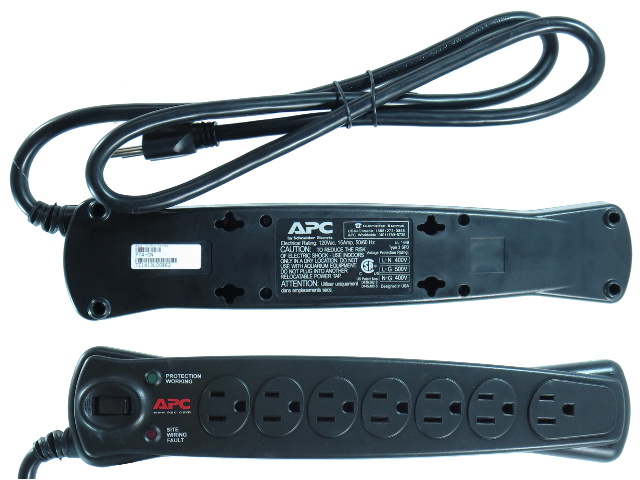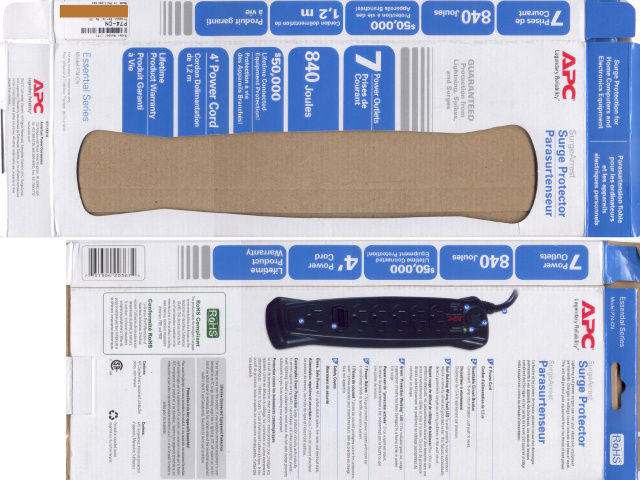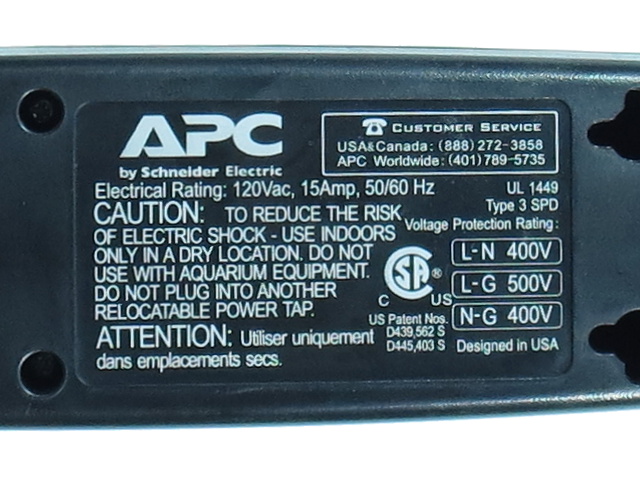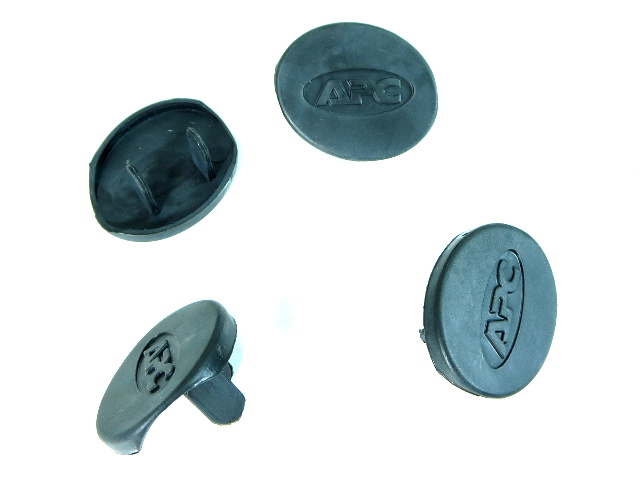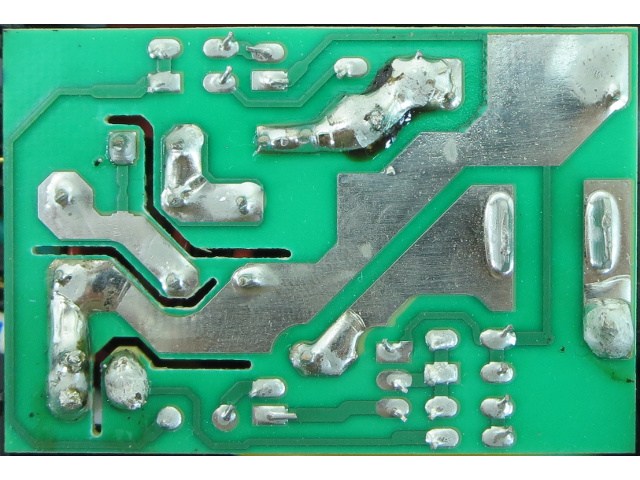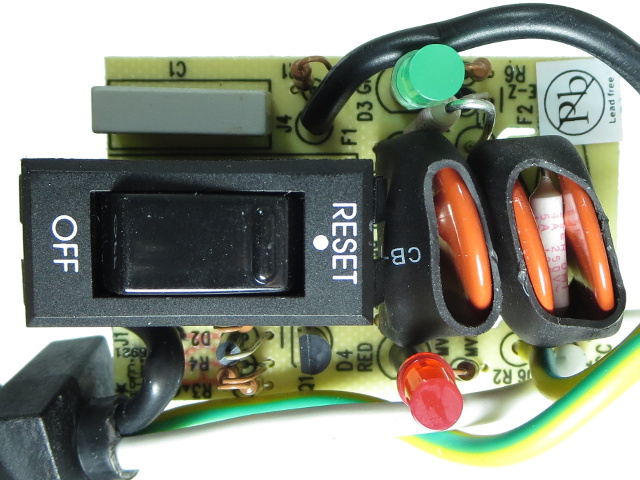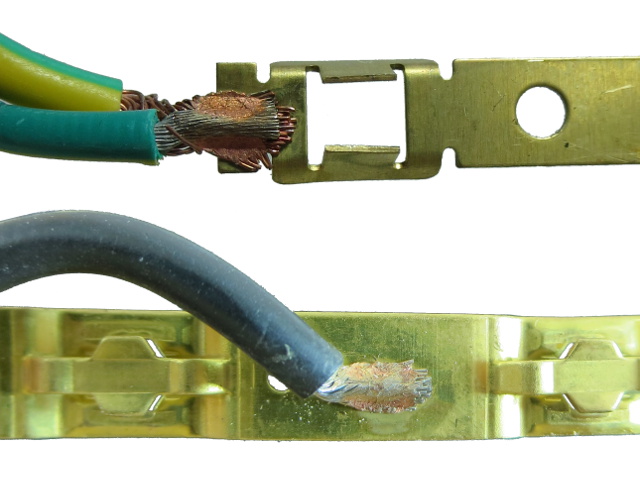Let's Take a Trip Inside Budget Power Bars, Part Three
In this third and final part of this series, we take a look at three units from some of the most popular brands in IT-related power products. All of your patience is about to pay off: we're also picking an overall winner.
Our Ninth Contestant: APC's P74-CN
This wasn't strictly the cheapest APC unit on NewEgg. But it was only $0.50 more expensive than the six-outlet variant at the time of purchase, so I decided to get the seven-outlet model.
It's the only unit in our round-up with a recessed switch and a wiring fault indicator. Like the Tripp-Lite, it also features a wall-wart-friendly elongated bottom pad.
What APC's Packaging Says
The P74 is the largest unit of today's hoard, it comes in the thickest and biggest cardboard of the bunch, and it's the only one with a packaging window. APC spared no expense on wrapping this thing up. The marketing department went nuts, filling nearly every available square centimeter with neatly formatted fine print.
Specifications include a 840-joule surge rating, which is the highest of the lot, and a $50,000 equipment protection warranty (also the highest).
APC's Label
Language discrimination strikes again. French-speaking users only need to worry about keeping the power bar dry, while English-speaking users also need to be wary of aquariums and plugging power bars into other power bars.
If you were looking for a UL logo or sticker on this particular model (as I was), you will not find any since it carries a CSA mark instead.
APC's Bonus Content
Of the nine units we're comparing, Diamond and APC are the only two vendors that include some form of outlet covers. With APC's offering, you get four branded caps instead of mechanical shutters.
Get Tom's Hardware's best news and in-depth reviews, straight to your inbox.
Inside Yet Another APC Product
This is the last unit of the day and its general layout is, unsurprisingly, similar to nearly every other bar. That PCB does look busier though, as you might expect from the presence of a wiring fault indicator.
APC's PCB
In my modern-day SurgeArrest tear-down, some readers expressed doubts about the soldering quality, suggesting the possibility of receiving a curated review sample. Well, our P74-CN came straight from NewEgg and the soldering on it looks every bit as good as the review sample I received from APC back then.
APC's Components
APC's PCB is fully populated. On the bottom-left, we have the wiring fault circuitry, while the protection-good circuitry resides in the top-right corner. The top-left holds a 100nF X-cap for basic EMI filtering, and the MOVs are tied to their respective thermal shut-off with thick shrink-tubing.
Lifting APC's Skirts
Since I couldn't see part numbers with those tubes on, I decided to pull them off. I was expecting to see different MOVs used for live-ground, due to the 500V rating, but all three turn out to be GNR 20D201K.
Toasty
Since MOVs fail by either increased leakage current, dropping varistor voltage or shorting, they need thermal shutoffs to cut power after they fail. However, those fuses do not operate instantaneously, so a failing MOV may still catch on fire or explode before then. This piece of flame-resistant cardboard prevents MOVs from burning or blowing out straight through the top, helping contain catastrophic failures (hopefully) long enough for the fuses to blow and flame retardants in surrounding materials to put the fire out.
APC's Strips
And here are our last strips of the trip, which employ spot-welding to attach the wires. The welds look good except for one loose strand on the ground wire.
As far as dimensions are concerned, the power strips are reasonably chunky at 6.5mm wide by 0.45mm thick, while the ground strips are slightly better than average at 3.5mm by 0.4mm.
-
Amdlova thank you daniel for another bad trip. when i look for those bars i have a bad feeling about what happens inside of it.Reply -
babernet_1 Is it just me? For this and another similar presentation I can only get one picture switch then the rest of the pics are locked, I cannot see them.Reply -
Daniel Sauvageau Reply
Those last three were fairly decent and the Belkin was not too bad either as far as basic surge protection go.15085733 said:thank you daniel for another bad trip. when i look for those bars i have a bad feeling about what happens inside of it.
If you want dangerous everyday stuff, someone asked me to take a look inside their LG microwave yesterday. Complaint: not heating up. Cause of failure: door safety micro-switch rated for only 0.6A at 125V in series with the HV transformer which should draw at least 10A based on the oven's 1100W rating, likely more due to reactive power and crest factor. The connector covers were melted and partially carbonized onto the switch. -
rdc85 Reply15086478 said:Is it just me? For this and another similar presentation I can only get one picture switch then the rest of the pics are locked, I cannot see them.
usually caused by connection problem (lag)..
try refresh and wait a while the pic is loading...
-
hydac8 How about doing a tear down of European power strips ? I'm sure it would be interesting for non US residentsReply -
synphul Doesn't surprise me, seems like as time goes on and tech 'improves' basics get crappier. Most anything electrical anymore is a fright fest, especially compared to older 'outdated' things. I've noticed this with a variety of electrical appliances. Old funky power bars no one gave a second thought about just worked. New ones with all the bells and whistles are melting down.Reply
Who used to worry much over their psu for their pc? So long as it had an appropriate wattage rating, it just worked. Now? Buzzing, popping noises, puffs of smoke, melted sata power wires, you name it. Literal Chernobyl in a box. Countless stories recently of people using electric heat tape to keep their pipes from freezing (since it's winter here in the u.s.) and fires breaking out. Many just from friends of mine alone who have smelled burning and smoke and panicked, shut off their main house power. Fire dept confirmed they did the smart thing since it was burning their home's insulation and about to start a major house fire.
I've personally had 2 electric heaters just within the past couple of months getting so hot that they melt the plugs. To the point the contact spades are literally falling out of them and the plastic insulated plug head is like goo. On a 1500w heater, that's ridiculous (although at least I didn't experience blue sparks or smoke/flames emitting from the front as others have). That's not a 'cheapy' either, it was a $100 DeLonghi. Everything electrical anymore is flat getting scary terrible in build quality and worse than not performing as we'd hoped is becoming a health and fire hazard. -
Daniel Sauvageau Reply
The main problem with that would be the basic fact that european power accessories are not readily available in North America.15092925 said:How about doing a tear down of European power strips ? I'm sure it would be interesting for non US residents
If you want something frightening, I saw a video on youtube a few months ago of someone doing dangerous appliance tear-downs. I do not remember if it was an Euro or Australian bar but it was absolutely horrible: packaging said it had a fuse or breaker but there were none, it said it had surge protection but there was none, same for filtering. It claimed to be heavy-duty but its power cord was copper-plated aluminum thinner than #16. The outlets were strung together using #18 gauge copper-plated aluminum. Wiring insulation started melting with the bar passing merely 8A out of its 16A rating. At 10A, wiring caught on fire. Packaging claimed the product used fire-resistant material but the plastic failed to put itself out after power was removed.15097247 said:Doesn't surprise me, seems like as time goes on and tech 'improves' basics get crappier. Most anything electrical anymore is a fright fest, especially compared to older 'outdated' things.
I think none of the units I had in my three parts tear down come anywhere near that horrible - though I did not do actual load/conductivity or flamability tests.
